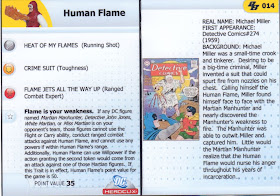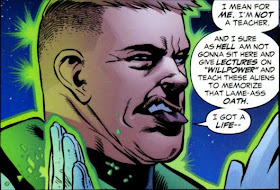You know what’s missing from Heroclix?
Bodies.
Warm, living, innocent civilian bodies (or at least tiny cold plastic representations thereof). In a “real” comic book battle, one of the most common issues is the welfare of the innocent bystanders. How often the hero has to “take the fight away from this populated area”. How often the weaker but more mobile team-members are assigned crowd control and evacuation. How often an evildoer takes a hostage to proof himself against batarangs, plastic-cat arrows, and ill-defined energy blasts. Without such opportunities, how’s a villain supposed to do his job?
Yet Heroclix battles seem to take place in an unpeopled social vacuum, an oddly tidy post-apocalyptic wasteland where no signs of life remain other than abandoned hot-carts and bubblegum machines. There are no elders, no adults, no children, no pets, no birds, no bugs, and no airborne viruses. Nothing but capes and criminals. And Lois Lane.
And that’s just not how the real (?) comic book world is. So I’ve begun incorporating bystanders into my Heroclix games.
Heroclix did originally began with Bystanders as part of the game. They were tokens—pogs, as it were—of either stock characters (e.g., “The Politician” or “The Paper Boy”) or of well-known supporting characters (e.g. “Alfred Pennyworth” or “Linda Park”). Wizkids (makers of Heroclix) clearly had a sense that such characters needed to be included in the game, but they gave insufficient thought to making an appropriate role for them in the game’s mechanics. As a result, the on-line forums for Heroclix players blossomed with strategies like Superman using baby Lian Harper as a ‘meat shield’ to protect himself, Alfred’s enduring partnership with the Legion of Super-Heroes as their camouflage expert, and how Galactus can conquer the universe aided only by an army of clones of Aunt May.
Over time, Wizkids realized that Heroclix’s ability to represent comic book characters accurately is one of its competitive advantages, and one that distinguishes it from a host of other table-top games. Heroclix is at least as much about its four-color atmosphere as it is game mechanics. Within that in mind, they’ve discontinued “pogs” (along with the out-of-character strategies they fostered) and have made some of the more important supporting characters into regular figures (e.g. Alfred, Commissioner Gordon, Lois Lane).
But my nature abhors a social vacuum, so recently I’ve been adding bystanders back into the mix as part of my house rules for the game. And you can, too!
Buy Standers
You could use pennies or beads to represent bystanders but it ruins the flavor of the game. It would be like playing Heroclix with no sculpts on the dials and with only terrain markers on the maps. Just do what I did, go to the dollar store and buy some toy soldiers or firefighters or such. They are recognizable as people, similar to Heroclix in size, stand up on their own, and easily distinguished from the “real” figures in the game. You’ll need about 40.
Extras Find their Marks
After the real game pieces have been set up in their starting areas, place the bystanders as follows.
· Do not put any in the starting area rows or the row adjacent.
· For each other row, roll a pair of dice of two different colors (let’s say, one red and one blue). The red die tells you where to place figures to the right of the spine of the map (the line between Columns H & I) and the blue one is for the left. For example, if for Row 4 you roll a Red 1 and a Blue 6, you would place a bystander at I4 (one space to the right of the spine) and at C4 (six spaces to the left of the spine). If you want bystanders to be sparser, roll two dice for each side rather than one. Treat a roll of nine as if it were a one, and if you roll 10-12, omit placing the figure.
· If a square is blocked, just skip putting a bystander there.
· Repeat the process for Rows 4 through 21, and you’ll have bystanders randomly distributed throughout the map.
“Get out of my way, inferior beings!”
Bystanders block lines of sight. Non-flying figures (including bystanders) cannot move through a square occupied by a bystander. Bystanders are neutral figures with regard to breakaway. Bystanders are affected by hindering terrain and blocking terrain as normal.
“EEK!”
Bystanders have only one goal: run away from the fighting. Because when a guy with a bow and arrow starts shooting at a talking gorilla in your airport terminal, you change your travel plans mighty fast. None of this “Gosh, the Spoiler needs our help!” or “If you want to hurt Halo you’ll have to get through me!” nonsense for our bystanders; they are practical people, with other, non-combat places to be Besides, since they live in the DCU, they’ve see all this already. So at the end of each round of turns, they try to run away. But how? And whither?
Bystanders head for the closest exits, of course. You need to decide in advance where those are. What makes sense as an exit depends on what map you’re playing on, of course, but a good ‘default exit’ is the starting areas. That way, both teams are sure to have panicked citizens pouring toward them as they wade their way into battle.
At the end of each round of turns, one die is rolled to determine movement for all the bystanders. Each bystander moves toward the closet exit, as many squares as the die roll (and other obstacles) permit. They should always move, if possible, away from regular figures, as well. For example, if a regular figure is directly between a bystander and an exit, the bystander will, obstacles permitting, move diagonally so that he’s both moving both toward the exit and away from the figure. Although all bystanders get a move after each round, they don’t exactly move simultaneously; ones on outer rows move first, followed by the inner rows. So, first the ones in Rows 4 and 21 are moved, followed by those in Row 5 and 20, etc.
With the right terrain, the bystander will create unpredictable logjams that regular figures will have to work around until the citizens clear out. After a few rounds, almost all the bystanders will have escaped, except for those who have become …
HOSTAGES!
I love this part. Bystanders aren’t just ‘moving terrain’; they’re ‘special objects’, too. Villains can, if you wish, land on the same square as a bystander and take it hostage. Hostages function sort of like objects, except a figure doesn’t need superstrength to “carry” one.
Villains with a hostage:
· Move at half their speed
· Cannot be the target of a ranged attack
· Get plus one to their Defense against close combat attack
· Can, if they have superstrength, throw the hostage at an opponent up to six squares away to whom he has line of fire; this action incapacitates the opponent automatically (because they have to ‘catch’ the hostage). The hostage is then placed adjacent to the hero, but not in between the hero and the hostage-taker.
Naturally, the main advantage to hostage-taking is immunity from ranged attack. Sick of getting bopped by batarangs from the shadows? Grab a hostage! Oh, and no sneaky rules-lawyering to get around the direct attack thing. No fair trying to zap the hostage-taker with Pulse Wave or splash damage or Force Blast; don’t want to hurt an innocent hostage!
Now, if you’re automatically thinking, “Well, how can I tell the difference between a villain and a hero? How do I make such an arbitrary distinction not covered by the keywords in the game? And what if I’m playing two teams of heroes against each other?” Well, if that’s what you’re thinking, then I can’t help you and you’re probably playing Marvel Heroclix anyway.
“RUN!”
Hostages can escape from villains:
· If a hero does damage to the hostage-taker, or
· If a player uses an action to give him a chance to breakaway (which requires a roll of six), or
· If the hostage-taker makes a critical miss or
· If the hostage-taker has two action tokens on him, and adjacent hero breaks away, the hero can carry the hostage off with him, releasing it in a square adjacent to wherever he stops.
In these cases the hostage is ‘released’ into an adjacent square, then to run away to be interviewed by Clark Kent, looking for a human interest angle to the latest super-donnybrook.
Is this a foolproof, watertight addition to the regular rules of the game without any unforeseen issues for game mechanics? HECK, NO!
But it is fun, gives the villains a fighting chance, and feels a lot more like a comic book than a battle in an utterly barren landscape.













 "Rescue us!', the toys cry; "Save us from the horror and the screams!"
"Rescue us!', the toys cry; "Save us from the horror and the screams!" Actually, Guy...
Actually, Guy...


 You're as cuddly as the Axis,
You're as cuddly as the Axis,




 stolen character from Jack Cole.
stolen character from Jack Cole.








 Iris We-est! Your role is an appalling parody overflowing with the most disgraceful assortment of sexist imaginings, with your hair in
Iris We-est! Your role is an appalling parody overflowing with the most disgraceful assortment of sexist imaginings, with your hair in
 You're a torrid, horrid, skunk.
You're a torrid, horrid, skunk.




